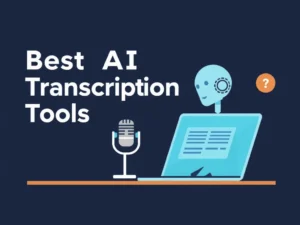Transcribing podcasts is now easier with AI. The best AI transcription tools can quickly turn your audio into accurate text, saving time and boosting accessibility. This guide highlights the top tools every podcaster should use to streamline their workflow and reach a wider audience.
Best AI Transcription Tools for Podcasters
Why More Podcasters Are Using AI Transcription Tools
Podcasting has grown fast in the past few years. There are millions of podcasts online now. People love listening to them while working out, cooking, or driving. But most podcasts are only audio. Audio is hard to search, read, clip, or quote without extra tools.
That’s where AI transcription comes in.
AI transcription turns spoken words into text. The process is fast. It’s also cheaper than asking humans to type everything by hand. With transcription, podcasters can reach more people, save hours editing, and share their content in new ways.
Big or small, solo or group shows—it’s now common for creators to use AI transcription tools. Some tools also let users edit podcast content by just editing words on the screen. Others support speaker labels, timestamps, and even multiple languages. These features help make podcast production faster, easier, and more professional.
Why Transcripts Matter for Every Podcast
A podcast should be more than just something to listen to. Most people read search results. They can’t find you if your words are stuck inside an audio file.
Transcripts Help with Discoverability
Search engines read text, not sound. So if your podcast has a transcript, it can show up in Google searches. That means more people can find your show, including those who didn’t know it before.
For example, if your episode is about “budget travel for students” and your transcript includes those words many times, Google can suggest it to people who are searching that topic.
Transcripts Increase Content Value
Every transcript can turn into many things. You can turn them into blog posts, quote cards, social media content, newsletters, or scripts for videos. A 30-minute episode could turn into 5 new pieces of content without much effort.
Transcripts Make Your Podcast More Accessible
Some people are deaf or hard of hearing. Others speak different languages. Some just prefer reading. Transcripts help them all take part. Also, making your content accessible may be required by law in some places. It’s not only about being fair—it’s also smart.
Editing is Easier with Transcripts
Instead of listening to the same clip again and again, you can just read the transcript and skip to the part you want. This saves a lot of time, especially with long interviews or multi-guest panels.
Perks of Using AI for Podcast Transcription
Saves Time
AI can transcribe audio in minutes. Manually doing it may take hours. Also, most AI tools are cloud-based, so you don’t need to install anything. Just upload, wait a little, and get the full text.
Cuts Down Production Work
Many AI tools let you edit shows by clicking or deleting words in the transcript. Some even match the changes with the audio or video right away. This means no back and forth cuts in a sound editor.
Speeds Up Publishing
Some tools let you connect directly to YouTube, Spotify, or your podcast host. Once your podcast is ready, it can get transcribed, edited, and shared all in one process.
Supports Team Collaboration
Writers, editors, and marketers can all use the same transcript. That keeps things clear. Everyone works from the same source, which avoids mistakes and saves time.
Key Features to Look For in AI Transcription Tools
Not all transcription tools are the same. Before picking one, here are some must-have features to check.
High Accuracy
Low-quality transcripts can cause confusion. You may misquote someone or publish wrong information. Tools that offer 85–95% accuracy, even in noisy audio, are better for podcast use. Make sure your tool can understand different accents too.
Speaker Labels
Multiple speakers are common in interviews and panel shows. A good tool shows who said what. Some tools label speakers automatically. Others let you name them after the recording.
Real-Time or Post-Recording Options
Real-time transcription is great for live shows or events. Post-recording (also called batch transcription) allows deeper processing. Transcripts are often more accurate this way. Pick the one that fits how you record.
Timestamps
This feature shows you the time each word or sentence was said. It’s helpful when making show notes or looking for good quotes.
Language and Accent Support
Some tools support dozens of languages and accents. This helps if you speak with guests from different places or if you want to reach a global audience later.
Easy Edits and Exports
The best tools make it simple to correct errors and save the file in different formats (like PDF, TXT, or SRT for subtitles).
Integration with Podcast Platforms
Some tools allow one-click upload to your podcast host or social channels. Others even allow transcript embeds on your website. This helps reduce extra work and improves workflow.
The Top AI Transcription Tools for Podcasters in 2025
Let’s look at the top tools being used by podcasters this year. Each has strong points, different pricing, and unique features.
1. Descript
Best For: Editing podcasts using text
Features:
- Transcription with high accuracy
- Multitrack editing
- Speaker detection
- Voice cloning (called Overdub)
- Audio cleanup tool (Studio Sound)
- Screen recording included
Pricing:
- Free: Limited use
- Creator Plan: $12/month
- Pro Plan: $24/month
Pros:
- Edit podcasts by deleting or changing text
- Built-in audio and video editor
- Works well for teams
Cons:
- Can feel complex at first
- Uses a lot of computer memory
2. Otter.ai
Best For: Real-time transcription and collaboration
Features:
- Real-time transcription
- Speaker identification
- Syncs with Zoom and Google Meet
- Word cloud and search options
- Highlights and shared notes
Pricing:
- Free: 300 minutes monthly
- Pro: $16.99/month
- Business: $30/month
Pros:
- Easy to use
- Great mobile app
- Real-time editing and collaboration
Cons:
- No deep editing features
- Fewer layout tools
3. Riverside.fm
Best For: High-quality remote podcast recordings
Features:
- Studio-quality recordings (even in low internet)
- Real-time AI transcription
- Speaker labels
- Magic Editor for text-based edits
- Multi-track files
Pricing:
- Free: Limited features
- Standard: $15/month
- Pro: $24/month
Pros:
- Great for remote interviews
- High-quality sound and video
- Transcribe and edit in one place
Cons:
- Setup might take time
- Best for those doing more than audio only
4. Rev AI
Best For: High accuracy with pro content
Features:
- Speech-to-text API
- Automated and human transcriptions
- Timecodes and speaker breakdown
- Custom dictionaries
Pricing:
- $0.25 per minute (AI transcription)
- $1.50 per minute (Human review)
Pros:
- Industry-level accuracy
- Great for branded or company podcasts
Cons:
- Higher cost if used often
- No native audio editing
5. Sonix
Best For: Multilingual podcast transcription
Features:
- 40+ languages supported
- Word confidence scores
- Audio-Word Highlight
- Subtitle creation
- Custom vocabulary
Pricing:
- Pay-as-you-go: $10/hour
- Premium: 22/month+22/month+5/hr
Pros:
- Fast and user-friendly
- Great for international creators
Cons:
- Costs can add up
- Fewer podcast platform integrations
Quick Comparison Table
| Tool | Best For | Price Range | Key Features |
| Descript | In-text podcast editing | $0–24/month | Transcript-based editing, overdub |
| Otter.ai | Real-time transcription | $0–30/month | Live speech-to-text collaboration |
| Riverside | Live interviews & studio sound | $0–24/month | Remote guest support + AI transcription |
| Rev AI | Accuracy with human help | 0.25–0.25–1.50/min | Professional-level transcription |
| Sonix | Foreign-language support | $10/hr+ | Multilingual, subtitle-ready |
How Podcasters Use These Tools in Real Life
Example 1: Weekly Business Podcast
A business coach used to hire a freelancer to type transcripts. It cost her time and money. She switched to Descript. She now edits faster and repurposes every transcript into website blogs, show notes, and promotional posts. Within three months, her website visits doubled.
Example 2: Advocacy Show
An activist podcaster started using Otter.ai to share transcripts right on the episode page. More listeners from the deaf community joined. Fans thanked him for making the content accessible. Back-end data showed a rise in keyword rankings too.
Example 3: International Travel Show
A travel podcast host used Sonix to translate episodes into Spanish, German, and Japanese. Within weeks, she got more plays from those countries. Her audience became truly global.
Challenges with AI Transcription and Simple Fixes
Low-Quality Audio or Accents
Sometimes, tools struggle with strong accents or background noise.
Fixes:
- Record with a good mic
- Ask guests to find a quiet place
- Use tools like Riverside that record locally (better audio)
Privacy Worries
Some podcasters work with sensitive topics.
Fixes:
- Pick tools with strong data rules
- Read their privacy policy
- Avoid uploading on public Wi-Fi
- Use multi-factor login
What’s Next in the World of Podcast Transcription
AI keeps getting better. You can now expect these upgrades soon:
- Emotion tags: Show words said with joy, sadness, or anger
- Auto summaries: Tools summarize your episode in seconds
- Real-time translation: Talk in English, read it in French
- AI dubbing: One voice turns into many in different languages
Tools like Descript and Trint are already testing these features. Good transcription may soon include tone, emotion, summaries, and even automatic show notes.
Final Thoughts
Podcasters today need more than just ideas and microphones. Clear, readable, and searchable transcripts help reach more people, work faster, and grow across platforms.
AI transcription is no longer a luxury. It’s now part of the modern podcast workflow.
Whether you run a solo show or manage an entire podcast team, tools like Descript, Otter.ai, Riverside, Rev AI, and Sonix offer something useful.
Start small. Try a free version. Test a clip. And build from there.












